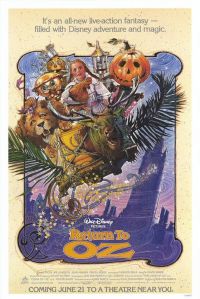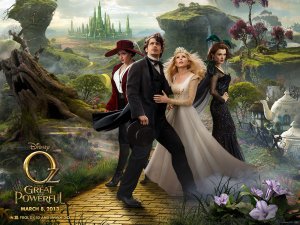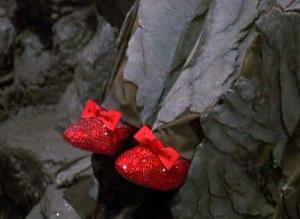Cross-posted from my academic blog.

 As successful in terms of audience as Oz the Great and Powerful is proving to be, critical appraisals have thus far been fairly negative. Is this another case of critics not seeing the merits of commercial cinema, or testament that the OZ myth is still too big to be hampered by a mediocre portrayal? One of the many things that the subsequent incarnations of Baum’s books and The Wizard of Oz have in common is that these stories are predominantly about the relationships between women. Oz the Great and Powerful is one of the only adaptions that I can think of which doesn’t rely on some incarnation of Dorothy, either as a protagonist or a catalyst. It has been a long time since we have seen Oz completely without Dorothy. What will this shift from witches to the wizard produce?
As successful in terms of audience as Oz the Great and Powerful is proving to be, critical appraisals have thus far been fairly negative. Is this another case of critics not seeing the merits of commercial cinema, or testament that the OZ myth is still too big to be hampered by a mediocre portrayal? One of the many things that the subsequent incarnations of Baum’s books and The Wizard of Oz have in common is that these stories are predominantly about the relationships between women. Oz the Great and Powerful is one of the only adaptions that I can think of which doesn’t rely on some incarnation of Dorothy, either as a protagonist or a catalyst. It has been a long time since we have seen Oz completely without Dorothy. What will this shift from witches to the wizard produce?
Part One: Oz, Disney and Authenticity
Tonight I am going to (finally) see Oz the Great and Powerful. Having heard two excellent papers on Disney’s previous attempt at an ‘official’ Oz film, Return to Oz, at the Returning to Oz: The Afterlife of Dorothy conference in February, I was in no doubt that OTGAP would be a box office smash.
As pointed out by Sorcha Ní Fhlainn and Carys Crossen in both of their seperate presentations on the 1985 film, this first foray of Disney into the lucrative world of Oz in film was a tempestuous creation, beset with shooting and management problems. The result was a melancholic, gothic cult classic that fits in better with the fantasy films of the 80s like The Dark Crystal and Labyrinth than anything else put out by the studio at the time. As far as Disney live action films of the period were concerned, Return to Oz resembled nothing of the Disney brand. It’s resemblance to films such as Labyrinth are not surprising considering director Walter Murch enlisted the Jim Henson Company to undertake the puppetry work for the film.

With Return to Oz Disney were expecting an official sequel to the 1939 MGM musical extravaganza. What they got was a quirky and slightly dark film that reseambled Baum’s books more than the musical. Their marketing department had a pretty tough time of it, as Ní Fhlainn and Crossen both mentioned in their papers.
Another thing that is striking about the Disney film is the contrast between Garland’s and Baulk’s portrayals of Dorothy. This is not only evident in their respective ages (Garland was 16, Baulk was 9) but also in their performances. Both films deploy the same Kansas-Oz-Kansas structure, although in the Disney version there is no sepia to Technicolor transition. However, in the latter film set six months later Dorothy, Aunt Em and Uncle Henry are attempting to adjust to life post-tornado and post-Oz. While Uncle Henry builds the family a new house, concern over Dorothy grows.  The little girl is not sleeping and continues to cling to her delusions about travelling to Oz. Desperate, Aunt Em takes Dorothy to an asylum where she is prescribed electroshock treatment. Significantly this treatment is attempted during a large storm. Dorothy is rescued from the treatment room by a mysterious girl. It is after the failed attempt to treat Dorothy that she escapes the asylum and, after losing consciousness, finds herself back in Oz. While many of the plot developments are recognisable from the 1939 film, including Dorothy’s access to Oz being reliant on her unconscious or dream state, the overt realism and sinister atmosphere of Return to Ozcontrasts distinctly with that of the earlier MGM film. Kansas loses its bland, homely feel. It becomes a terrifying place, where the Gale’s damaged, incomplete farm is indicative of Dorothy’s mental state. The administering of electroshock treatment denotes that this Dorothy is suffering from depression, or perhaps what we would recognise now as PTSD, something that is borne out in Baulk’s performance.
The little girl is not sleeping and continues to cling to her delusions about travelling to Oz. Desperate, Aunt Em takes Dorothy to an asylum where she is prescribed electroshock treatment. Significantly this treatment is attempted during a large storm. Dorothy is rescued from the treatment room by a mysterious girl. It is after the failed attempt to treat Dorothy that she escapes the asylum and, after losing consciousness, finds herself back in Oz. While many of the plot developments are recognisable from the 1939 film, including Dorothy’s access to Oz being reliant on her unconscious or dream state, the overt realism and sinister atmosphere of Return to Ozcontrasts distinctly with that of the earlier MGM film. Kansas loses its bland, homely feel. It becomes a terrifying place, where the Gale’s damaged, incomplete farm is indicative of Dorothy’s mental state. The administering of electroshock treatment denotes that this Dorothy is suffering from depression, or perhaps what we would recognise now as PTSD, something that is borne out in Baulk’s performance.
 The little girl is not sleeping and continues to cling to her delusions about travelling to Oz. Desperate, Aunt Em takes Dorothy to an asylum where she is prescribed electroshock treatment. Significantly this treatment is attempted during a large storm. Dorothy is rescued from the treatment room by a mysterious girl. It is after the failed attempt to treat Dorothy that she escapes the asylum and, after losing consciousness, finds herself back in Oz. While many of the plot developments are recognisable from the 1939 film, including Dorothy’s access to Oz being reliant on her unconscious or dream state, the overt realism and sinister atmosphere of Return to Ozcontrasts distinctly with that of the earlier MGM film. Kansas loses its bland, homely feel. It becomes a terrifying place, where the Gale’s damaged, incomplete farm is indicative of Dorothy’s mental state. The administering of electroshock treatment denotes that this Dorothy is suffering from depression, or perhaps what we would recognise now as PTSD, something that is borne out in Baulk’s performance.
The little girl is not sleeping and continues to cling to her delusions about travelling to Oz. Desperate, Aunt Em takes Dorothy to an asylum where she is prescribed electroshock treatment. Significantly this treatment is attempted during a large storm. Dorothy is rescued from the treatment room by a mysterious girl. It is after the failed attempt to treat Dorothy that she escapes the asylum and, after losing consciousness, finds herself back in Oz. While many of the plot developments are recognisable from the 1939 film, including Dorothy’s access to Oz being reliant on her unconscious or dream state, the overt realism and sinister atmosphere of Return to Ozcontrasts distinctly with that of the earlier MGM film. Kansas loses its bland, homely feel. It becomes a terrifying place, where the Gale’s damaged, incomplete farm is indicative of Dorothy’s mental state. The administering of electroshock treatment denotes that this Dorothy is suffering from depression, or perhaps what we would recognise now as PTSD, something that is borne out in Baulk’s performance.
It is not difficult to see how fans of the original MGM film would not have been satisfied with this sequel. The studio was not much happier as Murch’s film failed to deliver at the box office, reportedly costing the studio $29 million and being labeled a “high budget disaster”. Disney don’t often make mistakes at the box office, and even their arguably lesser quality straight to video or T.V. movies achieve their purpose in terms of returns. While surprising that the studio is willing to re-visit Oz after its last, less than successful venture there, what is not surprising is that this time the box office returns are much more healthy.
What it comes down to, and what will also be a major factor for Disney’s latest return to Oz on the big screen, is balancing authenticity and copyright. The original L. Frank Baum books are now public domain, but the film rights are slightly different. Samuel Goldwyn bought the rights to The Wonderful Wizard of Oz in 1933, and sold these rights to MGM in 1938. The studio used these rights to produce The Wizard of Oz in 1939 with Judy Garland and Margaret Hamilton. However, the film rights for the other thirteen books in the Oz series are owned by Disney. Copyright protection is a very big thing for studios, and Warner Bros., who now own MGM, are as well known for policing copyright infringement as Disney. In a market which is still plagued by reduced revenues due to piracy and illegal online streaming, the protection of copyrighted material for merchandising and other product productions is more important than ever.  This means that, while some of the elements of the MGM film that were taken directly from Baum’s book (such as Dorothy’s blue and white checked dress) aren’t rigorously policed, the more innovative and iconic parts which belong to MGM (such as Dorothy’s ruby red slippers) are the sole property of the studio. In Return to Oz Disney, believing that they were getting a true sequel to The Wizard of Oz, purchased the right to use the ruby slippers from MGM at great expense. Very few other filmmakers would go to such expense when they could use Baum’s original silver slippers for free. This leads to post-1939 versions of Oz having to make a conscious decision on which parts of which Oz to use in their adaptations, and can also lead to confused ideas about which Oz is recognised as the most authentic. This relationship to authenticity, and the non-linear chronology that results from such twisted perceptions of the various adaptations is something that I discussed in my own presentation on the afterlife of Dorothy in Maguire’s Oz.
This means that, while some of the elements of the MGM film that were taken directly from Baum’s book (such as Dorothy’s blue and white checked dress) aren’t rigorously policed, the more innovative and iconic parts which belong to MGM (such as Dorothy’s ruby red slippers) are the sole property of the studio. In Return to Oz Disney, believing that they were getting a true sequel to The Wizard of Oz, purchased the right to use the ruby slippers from MGM at great expense. Very few other filmmakers would go to such expense when they could use Baum’s original silver slippers for free. This leads to post-1939 versions of Oz having to make a conscious decision on which parts of which Oz to use in their adaptations, and can also lead to confused ideas about which Oz is recognised as the most authentic. This relationship to authenticity, and the non-linear chronology that results from such twisted perceptions of the various adaptations is something that I discussed in my own presentation on the afterlife of Dorothy in Maguire’s Oz.
 This means that, while some of the elements of the MGM film that were taken directly from Baum’s book (such as Dorothy’s blue and white checked dress) aren’t rigorously policed, the more innovative and iconic parts which belong to MGM (such as Dorothy’s ruby red slippers) are the sole property of the studio. In Return to Oz Disney, believing that they were getting a true sequel to The Wizard of Oz, purchased the right to use the ruby slippers from MGM at great expense. Very few other filmmakers would go to such expense when they could use Baum’s original silver slippers for free. This leads to post-1939 versions of Oz having to make a conscious decision on which parts of which Oz to use in their adaptations, and can also lead to confused ideas about which Oz is recognised as the most authentic. This relationship to authenticity, and the non-linear chronology that results from such twisted perceptions of the various adaptations is something that I discussed in my own presentation on the afterlife of Dorothy in Maguire’s Oz.
This means that, while some of the elements of the MGM film that were taken directly from Baum’s book (such as Dorothy’s blue and white checked dress) aren’t rigorously policed, the more innovative and iconic parts which belong to MGM (such as Dorothy’s ruby red slippers) are the sole property of the studio. In Return to Oz Disney, believing that they were getting a true sequel to The Wizard of Oz, purchased the right to use the ruby slippers from MGM at great expense. Very few other filmmakers would go to such expense when they could use Baum’s original silver slippers for free. This leads to post-1939 versions of Oz having to make a conscious decision on which parts of which Oz to use in their adaptations, and can also lead to confused ideas about which Oz is recognised as the most authentic. This relationship to authenticity, and the non-linear chronology that results from such twisted perceptions of the various adaptations is something that I discussed in my own presentation on the afterlife of Dorothy in Maguire’s Oz. As successful in terms of audience as Oz the Great and Powerful is proving to be, critical appraisals have thus far been fairly negative. Is this another case of critics not seeing the merits of commercial cinema, or testament that the OZ myth is still too big to be hampered by a mediocre portrayal? One of the many things that the subsequent incarnations of Baum’s books and The Wizard of Oz have in common is that these stories are predominantly about the relationships between women. Oz the Great and Powerful is one of the only adaptions that I can think of which doesn’t rely on some incarnation of Dorothy, either as a protagonist or a catalyst. It has been a long time since we have seen Oz completely without Dorothy. What will this shift from witches to the wizard produce?
As successful in terms of audience as Oz the Great and Powerful is proving to be, critical appraisals have thus far been fairly negative. Is this another case of critics not seeing the merits of commercial cinema, or testament that the OZ myth is still too big to be hampered by a mediocre portrayal? One of the many things that the subsequent incarnations of Baum’s books and The Wizard of Oz have in common is that these stories are predominantly about the relationships between women. Oz the Great and Powerful is one of the only adaptions that I can think of which doesn’t rely on some incarnation of Dorothy, either as a protagonist or a catalyst. It has been a long time since we have seen Oz completely without Dorothy. What will this shift from witches to the wizard produce?
No comments:
Post a Comment